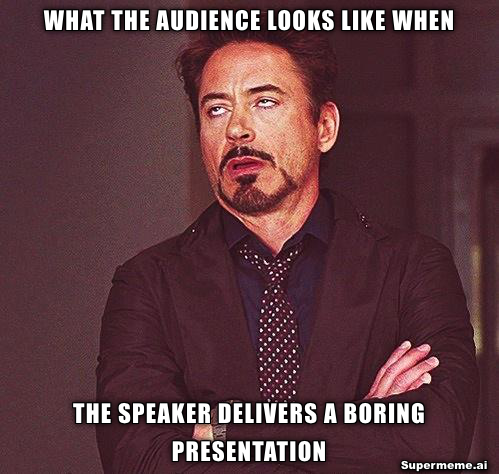How to use memes in presentations
Remember the last presentation you sat through? No? Exactly!
As part of our career and education, we've sat through a number of presentations but none of them are sticky because everyone follows the same approach to presentations.
In this article, we'll talk about why it's important to add humour in your presentation to make it stand out
Why use memes in presentations?
Help retain more information
Memes, often humorous in nature, can evoke positive emotions, capture attention, and create enjoyable learning experiences. This emotional engagement can lead to better information retention.
For Associative Learning
The novelty and unexpectedness of memes make them memorable, while their ability to create strong associations between concepts and ideas can aid memory recall. These associations can also encourage deeper cognitive processing.
For Social Bonding
Memes can foster social connections and shared experiences, positively influencing memory. Additionally, their humorous nature can reduce stress and anxiety, creating a more receptive learning environment.
How to use memes in your presentation?
Step 1 - Identify meme-able areas in your presentation
Look through your presentation and identify areas which are ideal to use memes. Remember, memes are a great tool to communicate problems.
So if your presentation topic is about a solution, consider using memes to highlight them problem to make it stick in your audiences head
Here are some areas to consider
- Icebreakers - to set the tone for the rest of the presentation
- Key Problems - to make them remember some of the problems you propose to solve
- Audience Engagement - to keep a slide in the background
- Changing mindsets - to challenge popular views or misconceptions
- Highlight success stories - to illustrate before and after for a success story
- Closing remarks - to leave them with one key message
For example, if I'm making a presentation on boring presentations. I would use a meme like this. Here I'm highlighting the key problem of how audience feel about wasting their time
Step 2 - Choose the areas to use them. Limit to 20%
Once you've identified the potential areas to use memes in your presentation, now you have to limit them. You should be mindful of the quantity and placement of memes throughout your presentation to maintain their effectiveness and avoid overwhelming your audience.
30% is a rough estimate. If you have a presentation of 50 slides (Why, though?) consider using no more than 10 memes.
Here are some questions you can ask yourself before choosing:
- Does this section contain a complex or abstract concept that could benefit from a simplified, visual explanation using a meme?
- Is there a key point or idea that needs to be emphasized, which could be reinforced by incorporating a relevant and memorable meme?
- Are there any moments in the presentation where audience engagement might start to wane, and a well-timed meme could help recapture their attention?
- Are there any common misconceptions or stereotypes related to the topic that can be addressed using a meme in a humorous yet thought-provoking manner?
- Can a meme be employed to encourage audience participation or interaction during a specific segment of the presentation?
Looking to use memes in your next presentation?
Try Supermeme.ai, an AI meme generator that can turn your text into memes.
Step 3 - Create memes and embed in slides
Once you have your meme-able areas in the presentation, you can start generating memes using any meme generator.
Here are some of the things to keep in mind while creating memes for your presentation
- Relevance: Make sure the meme you create is directly related to the topic of your presentation and reinforces the key points you're trying to convey.
- Audience appropriateness: Consider the demographics, interests, and preferences of your audience when creating memes. Ensure your memes are suitable, relatable, and respectful to avoid offending or alienating your audience.
- Simplicity and clarity: Create memes with simple, clear visuals and text that are easy to understand. Overly complex or confusing memes may fail to communicate your message effectively.
- Humor and tone: Aim for humor that is light-hearted, witty, and inoffensive. Be mindful of the tone to ensure it aligns with the overall mood and purpose of your presentation.
- Visual quality: Ensure that the images and text in your memes are high-quality, clear, and easy to read, even when projected on a large screen.
- Get feedback: Share your memes with a trusted peer or colleague to gather feedback on their effectiveness, clarity, and humor. Use this feedback to refine your memes before incorporating them into your presentation.
Once you have the memes ready, you can start placing them in the meme-able areas that you've identified earlier
Step 4 - Practice delivery
Just like any other presentation, practice is very important. However, when your presentation involves memes you need to take that extra step to make sure that the meme really lands. It's almost like performing standup comedy.
Before a meme slide:
- Practice: Rehearse the delivery, timing, and explanation of the meme to ensure seamless integration into your presentation.
- Set up context: Introduce the topic or concept related to the meme, preparing your audience to understand its relevance and message.
During a meme slide:
- Timing: Pause briefly before revealing the meme to build anticipation and give your audience time to absorb the humor.
- Maintain engagement: Maintain eye contact and use a confident, relaxed tone while presenting the meme.
- Clarify: Be prepared to explain or elaborate on the meme if necessary, ensuring your audience fully grasps its intended message.
- Gauge reactions: Observe the audience's reaction to the meme, and adjust your delivery or explanation accordingly.
After a meme slide:
- Reinforce the message: Summarize the key point or concept conveyed by the meme to emphasize its relevance and importance.
- Transition smoothly: Use the meme as a bridge to the next topic or section of your presentation, maintaining a steady flow and keeping your audience engaged.
- Invite interaction: Encourage audience questions, comments, or discussions related to the meme to foster a more dynamic and collaborative learning environment.
Incorporating memes into presentations can elevate audience engagement, simplify complex concepts, and create memorable experiences. By selecting relevant memes, crafting them thoughtfully, and delivering them effectively, presenters can strike the perfect balance between humor and professionalism, leaving a lasting impact on their audience.
FAQs
How can I maintain professionalism while using memes in presentations? To maintain professionalism, ensure the memes you use are relevant, appropriate, and align with the overall tone of your presentation. Balance humor with informative content, and avoid overusing memes to preserve credibility.
How can I ensure the humor in my memes is effective and inoffensive? Focus on light-hearted, witty humor that is relevant to your presentation's topic and audience. Avoid controversial, offensive, or overly niche jokes that may not resonate with your audience or could alienate them.
What factors contribute to the effectiveness of memes in presentations? Effective memes are relevant, clear, visually appealing, and appropriate for the audience. Their strategic placement within the presentation, combined with thoughtful delivery and timing, can enhance audience engagement and retention.
Can using memes in a presentation negatively impact my professional image? If memes are used excessively, inappropriately, or are unrelated to the topic, they may detract from your message and undermine your professional image. Use memes thoughtfully and sparingly to balance humor with professionalism.
How should I choose meme templates?
Focus on choosing templates that are both relevant to your presentation topic and suitable for your audience. Avoid offensive or NSFW templates.
Author
Sanjeev NC
Sanjeev is one of the co-founders of Supermeme.ai, an AI meme generator. Sanjeev has been creating memes for over a decade and now consults with companies on infusing humour in their marketing


